Discovery and Exploration of the Luming Porphyry Mo Deposit, Northeastern China: Implications for Regional Prospecting
Abstract
:1. Introduction
2. Regional Geology and Geophysics
3. Discovery History and Exploration Campaigns
4. Deposit Geology
4.1. Faults
4.2. Intrusive Rocks
4.3. Hydrothermal Breccias
4.4. Ore Body Characteristics
4.5. Ore Compositions and Textures
4.6. Wall Rock Alteration
4.7. Mineralization Phases
5. Material and Methods
6. Results
6.1. Major and Trace Elements
6.2. Primary Halo
6.3. Sample Physical Properties
6.4. Bouguer Gravity and Magnetic Anomalies
6.5. Resistivity and Chargeability
7. Discussion
7.1. Porphyry-Related Magmatic-Hydrothermal System
7.2. Control of Hydrothermal Breccias on Ore Distribution
7.3. Primary Halo and Metal Zonation
7.4. Indication of Geophysical Survey
7.5. Exploration Methods and Criteria
8. Conclusions
- (1)
- The identification of geochemical anomalies in stream sediments represents a pivotal element in the discovery of the Luming PMD. The combination of stream sediment geochemistry with large-scale soil geochemistry and geophysical surveys represents an effective exploration method. This integrated approach allows the rapid delineation of prospective targets for porphyry Mo deposits.
- (2)
- Hydrothermal breccias play a significant role in controlling mineralization and may act as conduits for ore-forming fluids.
- (3)
- The primary halo exhibits a distinct metal zonation, transitioning from a central W-Bi-Mo-(Sb) to a peripheral Cu-Co-Ni and distal Pb-Zn-Ag-In. The presence of Sb in the tail halo positions may suggest the possibility of deep-seated mineralization.
- (4)
- Gradient belts of aerogravity and aeromagnetic anomalies indicate the locations of the Luming PMD, while the deposit scale geophysical anomalies define the extent of mineralization and alteration. The mineralized rocks exhibit a low Bouguer gravity anomaly, a negative magnetic anomaly, moderate–low resistivity, and moderate–high chargeability.
- (5)
- It is proposed that the porphyry Mo and distal skarn-epithermal Pb-Zn mineralization at Luming may be parts of a single porphyry-related magmatic-hydrothermal system.
Supplementary Materials
Author Contributions
Funding
Data Availability Statement
Acknowledgments
Conflicts of Interest
References
- Wang, D.H.; Dai, H.Z.; Liu, S.B.; Wang, C.H.; Yu, Y.; Zhao, Z. Progress in strategic critical minerals exploration and production and proposals for a new round of prospecting in China. Sci. Technol. Rev. 2024, 42, 7–25, (In Chinese with English abstract). [Google Scholar] [CrossRef]
- Sinclair, W.D. Porphyry deposits. In Mineral Deposits of Canada: A Synthesis of Mzajor Deposit-Types, District Metallogeny, the Evolution of Geological Provinces, and Exploration Methods; Goodfellow, W.D., Ed.; Geological Association of Canada, Special Publication: St. John’s, NL Canada, 2007; Volume 5, pp. 223–243. [Google Scholar]
- Li, C.Y.; Liao, R.Q. Formation mechanism and geochemical process of porphyry molybdenum deposits. Acta Petrol. Sin. 2020, 36, 77–84, (In Chinese with English abstract). [Google Scholar] [CrossRef]
- Wu, H.Y.; Zhang, L.C.; Pirajno, F.; Shu, Q.H.; Zhang, M.; Zhu, M.T.; Xiang, P. The Mesozoic Caosiyao giant porphyry Mo deposit in Inner Mongolia, North China and Paleo-Pacific subduction-related magmatism in the northern North China Craton. J. Asian Earth Sci. 2016, 127, 281–299. [Google Scholar] [CrossRef]
- Shu, Q.H.; Chang, Z.S.; Lai, Y.; Zhou, Y.T.; Sun, Y.; Cong, Y. Regional metallogeny of Mo-bearing deposits in Northeastern China, with new Re-Os dates of porphyry Mo deposits in the northern Xilamulun district. Econ. Geol. 2016, 111, 1783–1798. [Google Scholar] [CrossRef]
- Zeng, Q.D.; Guo, W.K.; He, H.Y.; Zhou, L.L.; Cheng, G.H.; Su, F.; Wang, Y.B.; Wang, R.L. He, Ar, and S isotopic compositions and origin of giant porphyry Mo deposits in the Lesser Xing’an Range–Zhangguangcai Range metallogenic belt, Northeast China. J. Asian Earth Sci. 2018, 165, 228–240. [Google Scholar] [CrossRef]
- Yang, J.H.; Xu, L.; Sun, J.F.; Zeng, Q.; Zhao, Y.N.; Wang, H.; Zhu, Y.S. Geodynamics of decratonization and related magmatism and mineralization in the North China Craton. Sci. China Earth Sci. 2021, 64, 1409–1427. [Google Scholar] [CrossRef]
- U.S. Geological Survey. Mineral Commodity Summaries 2024; USGS2024; U.S. Geological Survey: Reston, VA, USA, 2024; p. 212. [CrossRef]
- Zeng, Q.D.; Liu, J.M.; Chu, S.X.; Wang, Y.B.; Sun, Y.; Duan, X.X.; Zhou, L.L. Mesozoic molybdenum deposits in the east Xingmeng orogenic belt, Northeast China: Characteristics and tectonic setting. Int. Geol. Rev. 2012, 54, 1843–1869. [Google Scholar] [CrossRef]
- Fan, Y.; Zhou, T.F.; Zhang, D.Y.; Yuan, F.; Ren, Z.; White, N. Spatial and temporal distribution and metallogical background of the Chinese molybdenum deposits. Acta Geol. Sin. 2014, 88, 784–804, (In Chinese with English abstract). [Google Scholar]
- Han, C.M.; Xiao, W.J.; Windley, B.F.; Zhao, G.C.; Su, B.X.; Ao, S.J.; Zhang, J.E.; Zhang, Z.Y.; Wan, B.; Cui, B.; et al. Re-Os age of molybdenite from the Daheishan Mo deposit in the eastern Central Asian Orogenic Belt, NE China. Resour. Geol. 2014, 64, 379–386. [Google Scholar] [CrossRef]
- Shu, Q.H.; Chiaradia, M. Mesozoic Mo mineralization in northeastern China did not require regional-scale pre-enrichment. Econ. Geol. 2021, 116, 1227–1237. [Google Scholar] [CrossRef]
- Li, Z.Z.; Qin, K.Z.; Li, G.M.; Shunso, I.; Jin, L.Y.; Song, G.X.; Meng, Z.J. Formation of the giant Chalukou porphyry Mo deposit in northern Great Xing’an Range, NE China: Partial melting of the juvenile lower crust in intra-plate extensional environment. Lithos 2014, 202–203, 138–156. [Google Scholar] [CrossRef]
- Shao, J.; Yang, H.Z.; Jia, B.; Peng, M.S. Geological characteristics and ore-forming age of Luming Mo deposit in Heilongjiang Province. Miner. Depos. 2012, 31, 1301–1310, (In Chinese with English abstract). [Google Scholar] [CrossRef]
- Li, L.X.; Song, Q.H.; Wang, D.H.; Wang, C.H.; Qu, W.J.; Wang, Z.G.; Bi, S.Y.; Yu, C. Re-Os isotopic dating of molybdenite from the Fu′anpu molybdenum deposit of Jilin Province and discussion on its metallogenesis. Rock Miner. Anal. 2009, 28, 283–287, (In Chinese with English abstract). [Google Scholar] [CrossRef]
- Hu, X.L.; Yao, S.Z.; Zeng, G.P.; Liu, W.H.; Zhang, Z.J. Multistage magmatism resulting in large-scale mineralization: A case from the Huojihe porphyry Mo deposit in NE China. Lithos 2019, 326–327, 397–414. [Google Scholar] [CrossRef]
- Ju, N.; Ren, Y.S.; Wang, C.; Wang, H.; Zhao, H.L.; Qu, W.J. Ore genesis and molybdenite Re-Os dating of Dashihe molybdenum deposit in Dunhua, Jilin. Glob. Geol. 2012, 31, 68–76, (In Chinese with English abstract). [Google Scholar] [CrossRef]
- Wang, Z.G.; Wang, K.Y.; Wan, D.; Konare, Y.; Yang, T.N.; Liang, Y.H. Metallogenic age and hydrothermal evolution of the Jidetun Mo deposit in central Jilin Province, Northeast China: Evidence from fluid inclusions, isotope systematics, and geochronology. Ore Geol. Rev. 2017, 89, 731–751. [Google Scholar] [CrossRef]
- Zhang, J.; Yang, Y.C.; Han, S.J.; Wutiepu, W. Geochronology, geochemistry, and Lu-Hf Isotopic compositions of monzogranite intrusion from the Chang’anpu Mo deposit, NE China: Implications for tectonic setting and mineralization. Minerals 2022, 12, 967. [Google Scholar] [CrossRef]
- Zeng, Q.D.; Liu, J.M.; Qin, K.Z.; Fan, H.R.; Chu, S.X.; Wang, Y.B.; Zhou, L.L. Types, characteristics, and time-space distribution of molybdenum deposits in China. Int. Geol. Rev. 2013, 55, 1311–1358. [Google Scholar] [CrossRef]
- Ge, W.C.; Wu, F.Y.; Zhou, C.Y.; Zhang, J.H. Porphyry Cu-Mo deposits in the eastern Xing’an-Mongolian Orogenic Belt: Mineralization ages and their geodynamic implications. Chin. Sci. Bull. 2007, 52, 3416–3427. [Google Scholar] [CrossRef]
- Yang, Y.C.; Han, S.J.; Sun, D.Y.; Guo, J.; Zhang, S.J. Geological and geochemical features and geochronology of porphyry molybdenum deposits in the Lesser Xing’an Range-Zhangguangcai Range metallogenic belt. Acta Petrol. Sin. 2012, 28, 379–390, (In Chinese with English abstract). [Google Scholar]
- Zhang, Y.; Sun, J.G.; Chen, Y.J.; Zhao, K.Q.; Gu, A.L. Re-Os and U-Pb geochronology of porphyry Mo deposits in central Jilin Province: Mo ore-forming stages in Northeast China. Int. Geol. Rev. 2013, 55, 1763–1785. [Google Scholar] [CrossRef]
- Zhang, Y.; Sun, J.G.; Xing, S.W.; Zhao, K.Q.; Ma, Y.B.; Zhang, Z.J.; Wang, Y. Ore-forming granites from Jurassic porphyry Mo deposits, east-central Jilin Province, China: Geochemistry, geochronology, and petrogenesis. Int. Geol. Rev. 2016, 58, 1158–1174. [Google Scholar] [CrossRef]
- Wang, Z.G.; Wang, K.Y.; Konare, Y.; Yang, T.N.; Liang, Y.H. Metallogenesis and hydrothermal evolution of Middle Jurassic porphyry Mo deposits in the southern Zhangguangcai Range, NE China: Evidence from fluid inclusions, H-O-S isotopes, and Re-Os geochronology. Int. Geol. Rev. 2017, 59, 1391–1412. [Google Scholar] [CrossRef]
- Shu, S.P.; Li, Q.G.; Liu, S.W.; Chen, Y.J. The origin and significance of the differences in petrogenesis and mineralization of porphyry gold, copper and molybdenum deposits. Earth Sci. Front. 2018, 25, 237–250, (In Chinese with English abstract). [Google Scholar] [CrossRef]
- Qu, P.; Li, N.B.; Niu, H.C.; Shan, Q.; Weng, Q.; Zhao, X.C. Difference in ore-forming magma between the Mesozoic porphyry Cu-Mo and Mo deposits in NE China: Records from apatite and zircon geochemistry. Ore Geol. Rev. 2021, 135, 104218. [Google Scholar] [CrossRef]
- Ju, N.; Zhang, D.; Zhang, G.B.; Zhang, S.; Ren, C.T.; Ren, Y.S.; Wang, H.; Wu, Y.; Liu, X.; Shi, L.; et al. Geology and mineralization of the Daheishan supergiant porphyry molybdenum deposit (1.65 Bt), Jilin, China: A review. China Geol. 2023, 6, 494–530. [Google Scholar] [CrossRef]
- Li, X.G.; Yang, J.F.; Yang, Y.C. Comprehensive geological, physical and chemical characteristics of Xinantun molybdenum deposit in central area of Jilin Province, and prospecting potential analysis. J. Jilin Univ. (Earth Sci. Ed.) 2024, 54, 1–20, (In Chinese with English abstract). [Google Scholar] [CrossRef]
- Zheng, W.; Yu, X.F. Geochronological and geochemical constraints on the petrogenesis and geodynamic setting of the Daheishan porphyry Mo deposit, Northeast China. Resour. Geol. 2018, 68, 1–21. [Google Scholar] [CrossRef]
- Liu, J.; Mao, J.W.; Wu, G.; Wang, F.; Luo, D.F.; Hu, Y.Q. Geochemical signature of the granitoids in the Chalukou giant porphyry Mo deposit in the Heilongjiang Province, NE China. Ore Geol. Rev. 2015, 64, 35–52. [Google Scholar] [CrossRef]
- Zhao, Q.; Zhai, D.; Mathur, R.; Liu, J.; Selby, D.; Williams-Jones, A.E. The giant Chalukou porphyry Mo deposit, Northeast China: The product of a short-Lived, high flux mineralizing event. Econ. Geol. 2021, 116, 1209–1225. [Google Scholar] [CrossRef]
- Hu, X.L.; Ding, Z.J.; He, M.C.; Yao, S.Z.; Zhu, B.P.; Shen, J.; Chen, B. Two epochs of magmatism and metallogeny in the Cuihongshan Fe-polymetallic deposit, Heilongjiang Province, NE China: Constrains from U-Pb and Re-Os geochronology and Lu-Hf isotopes. J. Geochem. Explor. 2014, 143, 116–126. [Google Scholar] [CrossRef]
- Chen, X.; Liu, J.J.; Carranza, E.J.M.; Zhang, D.H.; Collins, A.S.; Yang, B.; Xu, B.W.; Zhai, D.G.; Wang, Y.H.; Wang, J.P.; et al. Geology, geochemistry, and geochronology of the Cuihongshan Fe-polymetallic deposit, Heilongjiang Province, NE China. Geol. J. 2018, 54, 1254–1278. [Google Scholar] [CrossRef]
- Fei, X.H.; Zhang, Z.C.; Cheng, Z.G.; Santosh, M.; Jin, Z.L.; Wen, B.B.; Li, Z.X.; Xu, L.J. Highly differentiated magmas linked with polymetallic mineralization: A case study from the Cuihongshan granitic intrusions, Lesser Xing’an Range, NE China. Lithos 2018, 302–303, 158–177. [Google Scholar] [CrossRef]
- Zhang, Y.; Sun, J.G.; Xing, S.W.; Zhang, Z.J. Geochronology and geochemistry of the Cuihongshan Fe-polymetallic deposit, Northeastern China: Implications for ore genesis and tectonic setting. Can. J. Earth Sci. 2018, 55, 475–489. [Google Scholar] [CrossRef]
- Xing, K.; Shu, Q.H.; Lentz, D.R.; Wang, F.Y. Zircon and apatite geochemical constraints on the formation of the Huojihe porphyry Mo deposit in the Lesser Xing’an Range, NE China. Am. Mineral. 2020, 105, 382–396. [Google Scholar] [CrossRef]
- Xing, K.; Shu, Q.H.; Lentz, D.R. Constraints on the formation of the giant Daheishan porphyry Mo deposit (NE China) from whole-Rock and accessory mineral geochemistry. J. Petrol. 2021, 62, egab018. [Google Scholar] [CrossRef]
- Shu, Q.H.; Chang, Z.S.; Lai, Y.; Hu, X.L.; Wu, H.Y.; Zhang, Y.; Wang, P.; Zhai, D.G.; Zhang, C. Zircon trace elements and magma fertility: Insights from porphyry (-skarn) Mo deposits in NE China. Miner. Depos. 2019, 54, 645–656. [Google Scholar] [CrossRef]
- Zhu, J.H. Role and significance of geochemical exploration in the discovery of the Dayangshugou molybdenum deposit, Liaoning. Geol. China 2007, 34, 342–346, (In Chinese with English abstract). [Google Scholar]
- Han, Z.Z.; Zhao, H.L.; Li, J.J.; Luo, J.; Zhang, W.L.; Li, W.L. Metallogenic prognosis of porphyry style molybdenum mineralization potential in Xing’an area, Tieli city, Heilongjiang province. Geol. Explor. 2009, 45, 253–259, (In Chinese with English abstract). [Google Scholar]
- Meng, Z.J.; Kan, X.S.; Li, X.C.; Wang, J.P.; Zhang, R.Z.; Lv, K.P.; Sun, Z.J.; Shi, Y.J.; Zhang, J.N.; Wang, H.Y.; et al. The discovery and exploration process of the Chalukou giant porphyry molybdenum polymetallic deposit in forest-covered area of Northeastern Da Higgnan Mountains and its geological significance. Geol. China 2011, 38, 1504–1517, (In Chinese with English abstract). [Google Scholar]
- Hu, Y.X.; Zhang, B. Geophysical characteristics and anomaly model of the Luming molybdenum deposit in Heilongjiang Province. Met. Mine 2015, 1, 82–85, (In Chinese with English abstract). [Google Scholar]
- Yin, G.L.; Liang, K.W.; Yang, F.S.; Wen, D.; Wang, Y. A discussion on the geochemical characteristics of stream sediments and ore-prospecting orientation in Weixing-Anquan area of Heilongjiang Province. Geophys. Geochem. Explor. 2017, 41, 402–409, (In Chinese with English abstract). [Google Scholar] [CrossRef]
- Zheng, J.; Yan, H.; Hua, L. The physical characteristics of rock(ore) and prospecting indicator of porphyry Cu-Mo deposits in Duobaoshan ore district. Chin. J. Eng. Geophys. 2018, 15, 788–797, (In Chinese with English abstract). [Google Scholar]
- Tan, H.Y.; Shu, G.L.; Lv, J.C.; Han, R.P.; Zhang, S.K.; Lin, L. LA-ICP-MS zircon U-Pb and molybdenite Re-Os dating for the Luming large-scale molybdenum deposit in Xiao Hinggan Mountains and its geological implication. J. Jilin Univ. (Earth Sci. Ed.) 2012, 42, 1757–1770, (In Chinese with English abstract). [Google Scholar]
- Ma, S.Q.; Chen, J. Geochronology and geochemistry of granite of the Luming molybdenum deposit in Heilongjiang and their geological significance. Geol. China 2012, 39, 1162–1171, (In Chinese with English abstract). [Google Scholar]
- Liu, C.; Deng, J.F.; Luo, Z.H.; Tian, S.P.; Zhang, Y.; Zhong, C.T.; Selby, D.; Zhao, H.D. Post-batholith metallogenesis: Evidence from Luming super large molybdenite deposit in Lesser Xing’an Range. Acta Petrol. Sin. 2014, 30, 3400–3418, (In Chinese with English abstract). [Google Scholar]
- Hu, X.L.; Ding, Z.J.; He, M.C.; Yao, S.Z.; Zhu, B.P.; Shen, J.; Chen, B. A porphyry-skarn metallogenic system in the Lesser Xing’an Range, NE China: Implications from U-Pb and Re-Os geochronology and Sr-Nd-Hf isotopes of the Luming Mo and Xulaojiugou Pb-Zn deposits. J. Asian Earth Sci. 2014, 90, 88–100. [Google Scholar] [CrossRef]
- Sun, Q.L.; Sun, J.G.; Zhao, K.Q.; Tang, C.; Zhang, Y.; Han, S.J.; Yang, F. Re-Os isotopic dating and geological significance of Luming porphyry molybdenum deposit in Heilongjiang. Glob. Geol. 2014, 33, 418–425, (In Chinese with English abstract). [Google Scholar]
- Zhan, C.P.; Wang, E.D.; Bi, Z.W.; Chen, J. Geochemical characteristics of mineralization rock from the Luming molybdenum deposit in Heilongjiang Province. J. Northeast. Univ. (Nat. Sci.) 2014, 35, 1039–1042, (In Chinese with English abstract). [Google Scholar] [CrossRef]
- Cheng, G.H.; Wang, R.L.; Zeng, Q.D.; Guo, Y.P.; Duan, X.X.; Wei, J.J.; Zhang, J.S.; Gao, X.H. Zircon U-Pb ages, Hf isotopes of the granitoids and Re-Os ages of the molybdenites in Luming molybdenum ore area, Heilongjiang Province, and its geological significance. Acta Petrol. Sin. 2015, 31, 2450–2464, (In Chinese with English abstract). [Google Scholar]
- Wang, L.L.; Sun, F.Y.; Xu, J.H.; Wang, K.Y.; Wang, L.; Xu, Q.L. Ore-forming fluid and evolution of Luming molybdenum deposit, Heilongjiang Province. Acta Petrol. Sin. 2015, 31, 979–990, (In Chinese with English abstract). [Google Scholar]
- Chen, L.; Zhang, Y. In situ major-, trace-elements and Sr-Nd isotopic compositions of apatite from the Luming porphyry Mo deposit, NE China: Constraints on the petrogenetic-metallogenic features. Ore Geol. Rev. 2018, 94, 93–103. [Google Scholar] [CrossRef]
- Xi, A.H.; Ge, Y.H.; Liu, J.; Xu, B.W.; Li, B.L.; Zhu, Y.D. Discovery of adakite in Tieli Luming-molybdenum mine, Heilongjiang Province and its geological implications. Acta Petrol. Sin. 2018, 34, 719–732, (In Chinese with English abstract). [Google Scholar]
- Chen, Y.J.; Zhang, C.; Wang, P.; Pirajno, F.; Li, N. The Mo deposits of Northeast China: A powerful indicator of tectonic settings and associated evolutionary trends. Ore Geol. Rev. 2017, 81, 602–640. [Google Scholar] [CrossRef]
- Sun, J.G.; Zhang, Y.; Xing, S.W.; Zhao, K.Q.; Zhang, Z.J.; Bai, L.A.; Ma, Y.B.; Liu, Y.S. Genetic types, ore-forming age and geodynamic setting of endogenic molybdenum deposits in the eastern edge of Xing-Meng orogenic belt. Acta Petrol. Sin. 2012, 28, 1317–1332, (In Chinese with English abstract). [Google Scholar]
- Li, Z.L.; Zeng, Q.D.; Liu, J.M.; Friis, H.; Zhang, Z.L.; Duan, X.X.; Lan, T.G. Geochronology of magmatism and mineralization of the Daheishan giant porphyry molybdenum deposit, JilinProvince, Northeast China: Constraints on ore genesis and implications for geodynamic setting. Int. Geol. Rev. 2014, 56, 929–953. [Google Scholar] [CrossRef]
- Tan, H.Y. Metallogenetic Series and Prospecting Assessment in Lesser Xing’an Range-Zhangguangcai Range Metallogenic Belt of Heilongjiang Province. Ph.D. Thesis, China University of Geosciences (Beijing), Beijing, China, 2013. [Google Scholar]
- Xiong, S.Q.; Ding, Y.Y.; Li, Z.K.; Zhang, H.R.; Fan, Z.G.; Guo, Z.H.; Tong, J.; Zhou, D.Q.; Huang, X.H. Geomagnetic and Geological Structures of the Chinese Mainland: Interpretation of the Chinese Mainland 1:1,000,000 Aeromagnetic Anomaly Map; Geological Publishing House: Beijing, China, 2016. (In Chinese) [Google Scholar]
- Li, Y.C.; Han, Z.Z.; Wu, G.G.; Zhang, D. Metallogenesis and metallogenic differences of the early Mesozoic granites in the Yichun area, Heilongjiang Province. Geol. Exploation 2013, 49, 28–38, (In Chinese with English abstract). [Google Scholar]
- Zeng, G.P.; Hu, X.L.; Yao, S.Z.; Dong, Z.L.; Zhou, M.; Yang, J. Two epochs of Mo mineralization in Cuihongshan Fe-Mo-polymetallic ore field, Heilongjiang Province. Earth Sci.-J. China Univ. Geosci. 2022, 47, 309–324, (In Chinese with English abstract). [Google Scholar] [CrossRef]
- Tian, S.P. Geochemical Characteristics of Ore Rock in the Luming and Culling Mo Deposit, Heilongjiang Province. Master’s Thesis, Jilin University, Jilin, China, 2013. (In Chinese with English abstract). [Google Scholar]
- Chen, J. Metallogenic Setting and Metallogenesis of Nonferrous-Precious Metals in Lesser Hinggan Mountain, Heilongjiang Province. Ph.D. Thesis, Jilin University, Jilin, China, 2011. (In Chinese with English abstract). [Google Scholar]
- Cai, W.J.; Feng, C.Y.; Ni, W.C. Analysis and study of aeromagnetic anomalous characteristics of lead-zinc polymetallic deposits in Yichun area. Geophys. Geochem. Explor. 2016, 40, 869–875, (In Chinese with English abstract). [Google Scholar] [CrossRef]
- Jia, W.L.; Sun, J.S. Non-ferrous metal mineral prospecting report in Luming and Ping’an, Tieli City, Heilongjiang Province. Unpublished Technical Report in Chinese. 2005. [Google Scholar]
- Jia, W.L.; Sun, J.S. Geological Exploration Report of Luming Mo Deposit, Tieli City, Heilongjiang Province. Unpublished Technical Report in Chinese. 2006. [Google Scholar]
- Wang, Y.; Wang, W.L.; Dong, F.L.; Chen, Y.B.; Gao, B.F.; Chen, X.Q.; Xu, J.L.; Li, L.; Yu, H.J.; Zhang, W.Q.; et al. Verification report on the resource and reserve of Luming Mo deposit, Tieli City, Heilongjiang Province. Unpublished Technical Report in Chinese. 2011. [Google Scholar]
- Middlemost, E.A.K. Naming materials in the magma/igneous rock system. Earth Sci. Rev. 1994, 37, 215–224. [Google Scholar] [CrossRef]
- Roberts, M.P.; Clemens, J.D. Origin of high-potassium, calc-alkaline, I-type granitoids. Geology 1993, 21, 825–828. [Google Scholar] [CrossRef]
- Maniar, P.D.; Piccoli, P.M. Tectonic discrimination of granitoids. Geol. Soc. Am. Bull. 1989, 101, 635–643. [Google Scholar] [CrossRef]
- Sun, S.S.; McDonough, W.F. Chemical and isotopic systematics of oceanic basalts: Implications for mantle composition and processes. In Magmatism in the Ocean Basins; Saunders, A.D., Norry, M.J., Eds.; Geological Society of London, Special Publications: Oxford, UK, 1989; Volume 42, pp. 313–346. [Google Scholar] [CrossRef]
- Sillitoe, R.H. Porphyry copper systems. Econ. Geol. 2010, 105, 3–41. [Google Scholar] [CrossRef]
- Mao, J.W.; Zhang, J.D.; Pirajno, F.; Ishiyama, D.; Su, H.M.; Guo, C.L.; Chen, Y.C. Porphyry Cu-Au-Mo-epithermal Ag-Pb-Zn-distal hydrothermal Au deposits in the Dexing area, Jiangxi province, East China-A linked ore system. Ore Geol. Rev. 2011, 43, 203–216. [Google Scholar] [CrossRef]
- Catchpole, H.; Kouzmanov, K.; Putlitz, B.; Seo, J.H.; Fontboté, L. Zoned base metal mineralization in a porphyry system: Origin and evolution of mineralizing fluids in the Morococha district Peru. Econ. Geol. 2015, 110, 39–71. [Google Scholar] [CrossRef]
- Li, Z.K.; Bi, S.J.; Li, J.W.; Zhang, W.; Cooke, D.R.; Selby, D. Distal Pb-Zn-Ag veins associated with the world-class Donggou porphyry Mo deposit, southern North China Craton. Ore Geol. Rev. 2017, 82, 232–251. [Google Scholar] [CrossRef]
- Jin, L.Y.; Qin, K.Z.; Li, G.M.; Zhao, J.X.; Li, Z.Z. Characteristics, controlling factors and exploration implications of porphyry molybdenum-hydrothermal vein-style lead-zinc-silver metallogenic systems. Acta Petrol. Sin. 2020, 36, 3813–3839. [Google Scholar] [CrossRef]
- Chitalin, A.F.; Baksheev, I.A.; Nikolaev, Y.N.; Nagornaya, E.V.; Khabibullina, Y.N.; Nikolaeva, I.Y.; Kalko, I.A.; Müller, D. Porphyry-epithermal Cu-Mo-Au–Ag mineralization in the Nakhodkaore field, Baimka Trend, Chukotka, Russia: A geological, mineralogical, and geochemical perspective. Miner. Depos. 2023, 58, 287–306. [Google Scholar] [CrossRef]
- Lowell, J.D.; Guilbert, J.M. Lateral and vertical alteration-mineralization zoning in porphyry ore deposits. Econ. Geol. 1970, 65, 373–408. [Google Scholar] [CrossRef]
- Li, Z.Z.; Li, G.M.; Meng, Z.J.; Qin, K.Z.; Song, G.X.; Jin, L.Y.; Kan, X.S.; Wang, J.; Zhang, X.N. Petrofacies classification, characteristics and formation mechanism of breccias in Chalukou giant molybdenum deposit of Da Hinggan Mountains. Miner. Depos. 2014, 33, 607–624, (In Chinese with English abstract). [Google Scholar]
- Qing, M.; Wang, W.C.; Li, W.B.; Zhang, L.J.; Zhang, D.; Han, X.J. Exploration of porphyry Cu±Mo±Au deposits in island arc and continental margin arc environment: Application of geological indexes. Miner. Depos. 2019, 38, 1223–1244, (In Chinese with English abstract). [Google Scholar] [CrossRef]
- Escolme, A.; Cooke, D.R.; Hunt, J.; Berry, R.F.; Maas, R.; Creaser, R.A. The productor a Cu-Au-Mo deposit, Chile: A Mesozoic magmatic-hydrothermal breccia complex with both porphyry and iron oxide Cu-Au affinities. Econ. Geol. 2020, 115, 543–580. [Google Scholar] [CrossRef]
- Landtwing, M.R.; Dillenbeck, E.D.; Heinrich, C.A. Evolution of the breccia-hosted porphyry Cu-Mo-Au deposit at Agua Rica, Argentina: Progressive unroofing of a magmatic hydrothermal system. Econ. Geol. 2002, 97, 1273–1292. [Google Scholar] [CrossRef]
- Carranza, E.J.M.; Sadeghi, M. Primary geochemical characteristics of mineral deposits implications for exploration. Ore Geol. Rev. 2012, 45, 1–4. [Google Scholar] [CrossRef]
- Borden, R.K. Environmental geochemistry of the Bingham Canyon porphyry copper deposit, Utah. Environ. Geol. 2003, 43, 752–758. [Google Scholar] [CrossRef]
- Moradpouri, F.; Ahmadi, S.M.H.; Ghaedrahmati, R.; Barani, K. Geochemical evaluation of the surface erosion for a hidden Cu-Au porphyry deposit using soil samples along with 3D ore-body modeling. Arab. J. Geosci. 2022, 15, 1164. [Google Scholar] [CrossRef]
- Sun, W.T.; Zheng, Y.Y.; Wang, W.; Feng, X.; Zhu, X.S.; Zhang, Z.Y.; Hou, H.X.; Ge, L.S.; Lv, H.Q. Geochemical characteristics of primary halo and prospecting significance of the Qulong porphyry copper-molybdenum deposit in Tibet. Minerals 2023, 13, 333. [Google Scholar] [CrossRef]
- Liu, Y.; Xia, Q.L. Compositional balance analysis: A novel method for tectono-geochemical anomaly identification and blind ore deposit prediction. Appl. Geochem. 2024, 164, 105939. [Google Scholar] [CrossRef]
- Shu, Q.H.; Deng, J.; Chang, Z.S.; Wang, Q.F.; Niu, X.D.; Xing, K.; Sun, X.; Zhang, Z.K.; Zeng, Q.W.; Zhao, H.S.; et al. Skarn zonation of the giant Jiama Cu-Mo-Au deposit in Southern Tibet, SW China. Econ. Geol. 2024, 119, 1–22. [Google Scholar] [CrossRef]
- Stoltnow, M.; Weis, P.; Korges, M. Hydrological controls on base metal precipitation and zoning at the porphyry-epithermal transition constrained by numerical modeling. Sci. Rep. 2023, 13, 3786. [Google Scholar] [CrossRef] [PubMed]
- Clark, D.A. Magnetic effects of hydrothermal alteration in porphyry copper and iron-oxide copper-gold systems: A review. Tectonophysics 2014, 624–625, 46–65. [Google Scholar] [CrossRef]
- Mitchinson, D.E.; Enkin, R.J.; Hart, C.J.R. Linking Porphyry Deposit Geology to Geophysics via Physical Properties: Adding Value to Geoscience BC Geophysical Data. Geoscience BC 2013, Report 2013-14, p. 116. Available online: http://www.geosciencebc.com/reports/gbcr-2013-14/ (accessed on 10 January 2024).
- Han, Z.H.; Wang, R.; Tong, X.S.; Sun, F.; Li, Y.Y.; Liu, S.Y.; Xue, Q.W. Multi-scale exploration of giant Qulong porphyry deposit in a collisional setting. Ore Geol. Rev. 2021, 139, 104455. [Google Scholar] [CrossRef]
- John, D.A.; Ayuso, R.A.; Barton, M.D.; Blakely, R.J.; Bodnar, R.J.; Dilles, J.H.; Gray, F.; Graybeal, F.T.; Mars, J.C.; McPhee, D.K.; et al. Porphyry Copper Deposit Model, Chap. B of Mineral Deposit Models for Resource Assessment; U.S. Geological Survey Scientific Investigations Report 2010-5070-B; USGS Central Mineral and Environmental Resources Science Center: Denver, CO, USA, 2010; 169p.
- Riveros, K.; Veloso, E.; Campos, E.; Menzies, A.; Véliz, W. Magnetic properties related to hydrothermal alteration processes at the Escondida porphyry copper deposit, Northern Chile. Miner. Depos. 2014, 49, 693–707. [Google Scholar] [CrossRef]
- Howe, B.; Devriese, S.G.R. An empirical geophysical model for porphyry copper deposits in the Laramide Copper Province. In Proceedings of the 4th AEGC: Geoscience-Breaking New Ground-13-18, Brisbane, Australia, 13–18 March 2023. [Google Scholar]
- Howe, B.; Kroll, A. The geophysical response of the Tupinda Cu-Au-Mo porphyry prospect, Tabar Islands, Papua New Guinea. ASEG Ext. Abstr. 2010, 2010, 1–5. [Google Scholar] [CrossRef]
- Wang, Q.; Wang, X.; Cheng, Z.; Zhang, B.; Du, Z.; Yan, T.; Yuan, H.; Li, X.; Qiao, Y.; Liu, H. Geogas-carried metal prospecting for concealed ore deposits: A review of case studies in China. Minerals 2023, 13, 1553. [Google Scholar] [CrossRef]
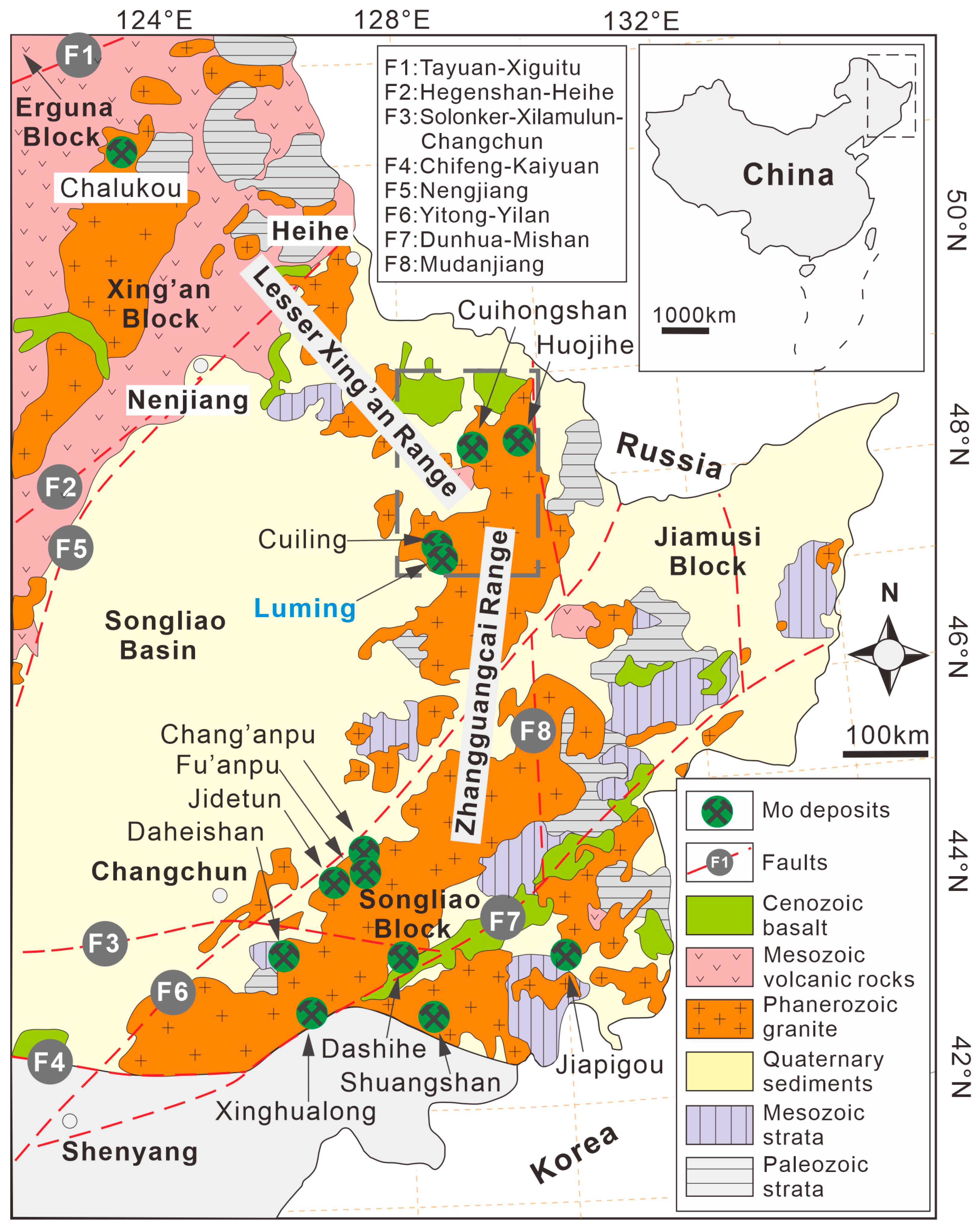
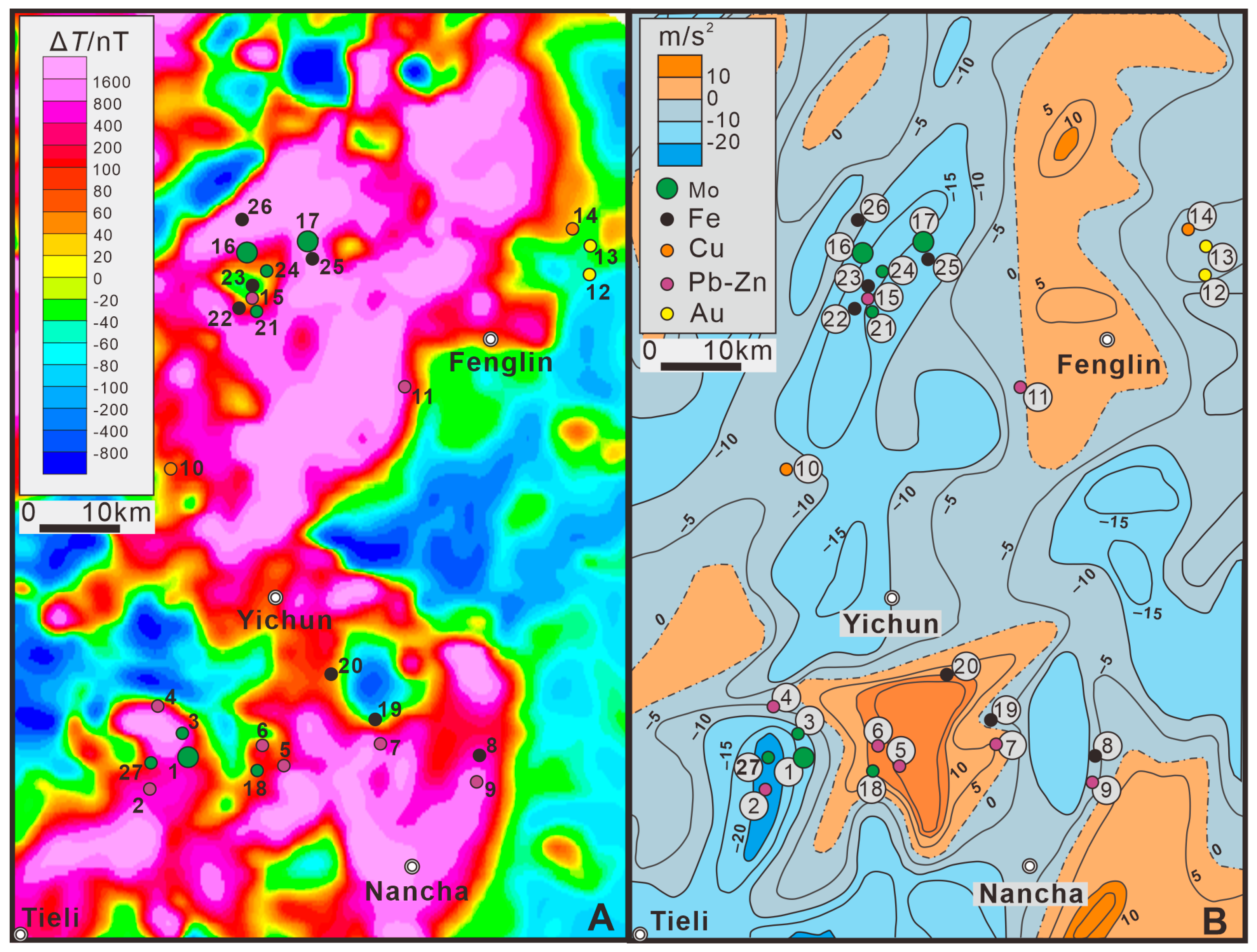
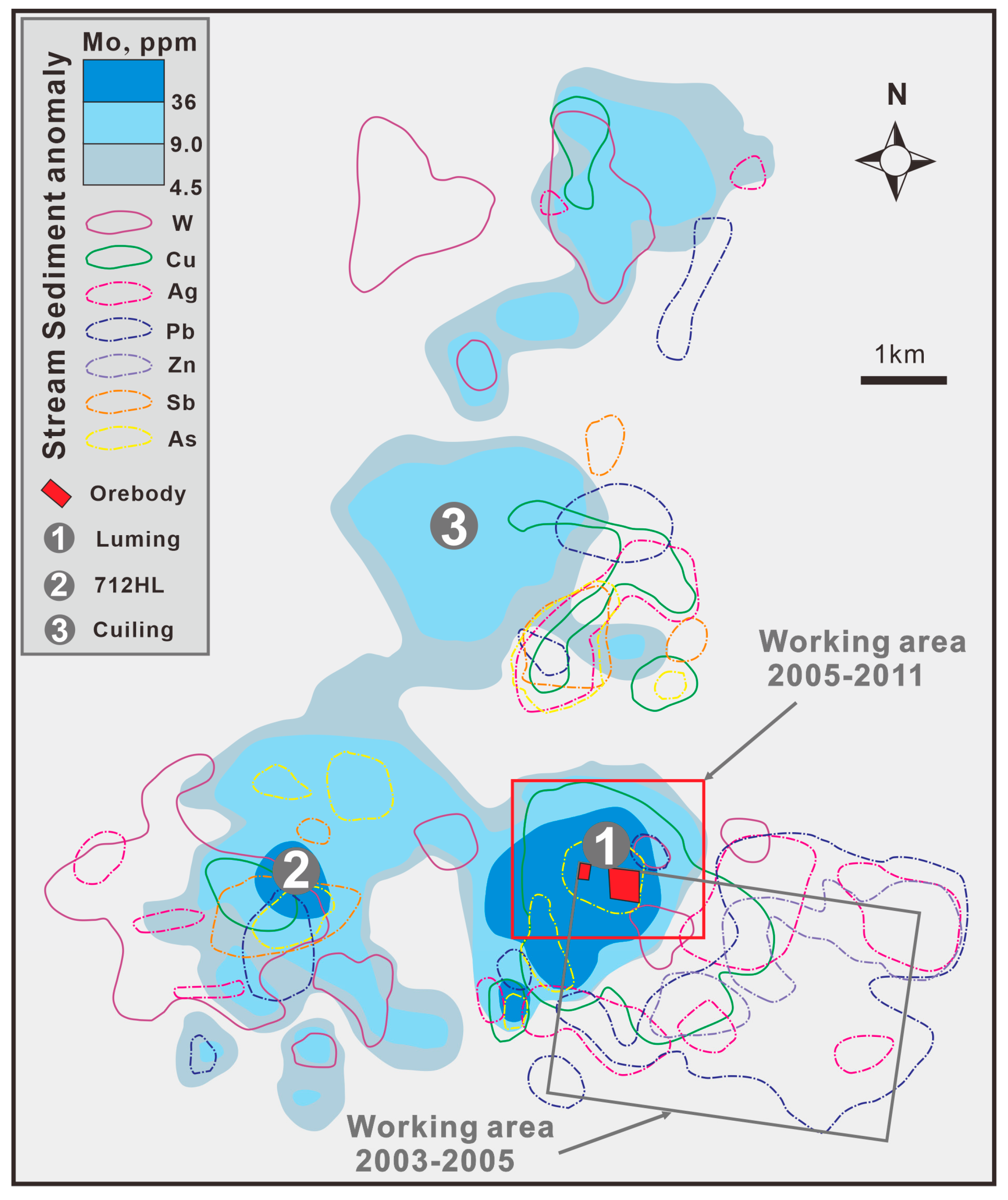





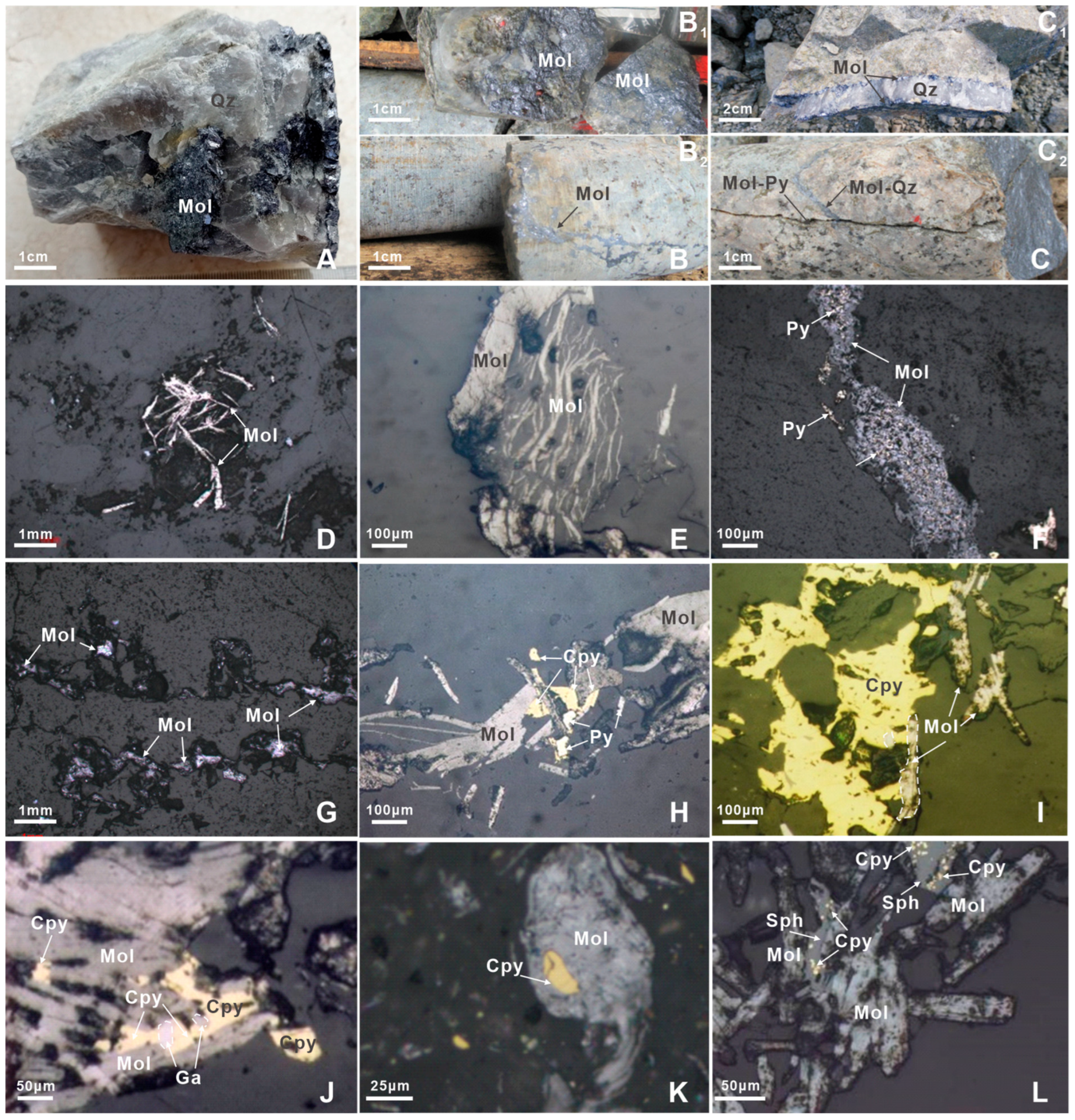
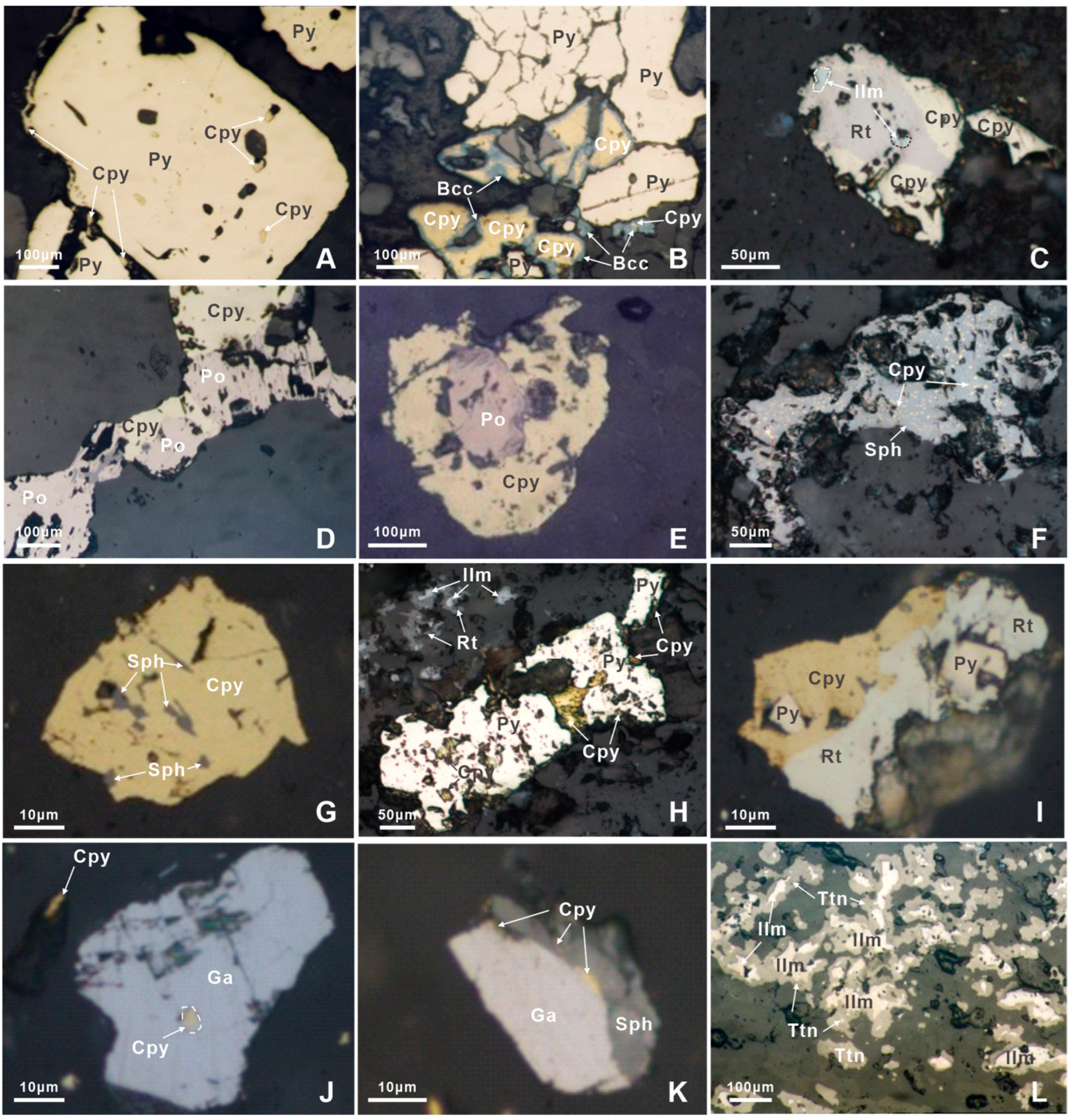



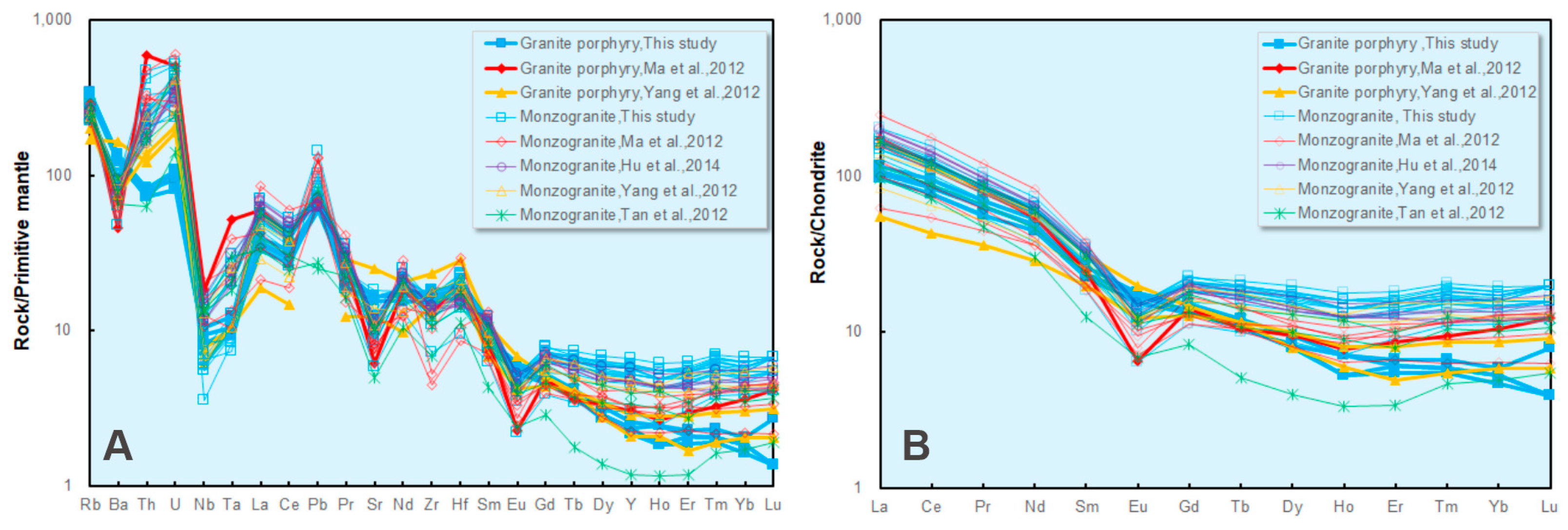
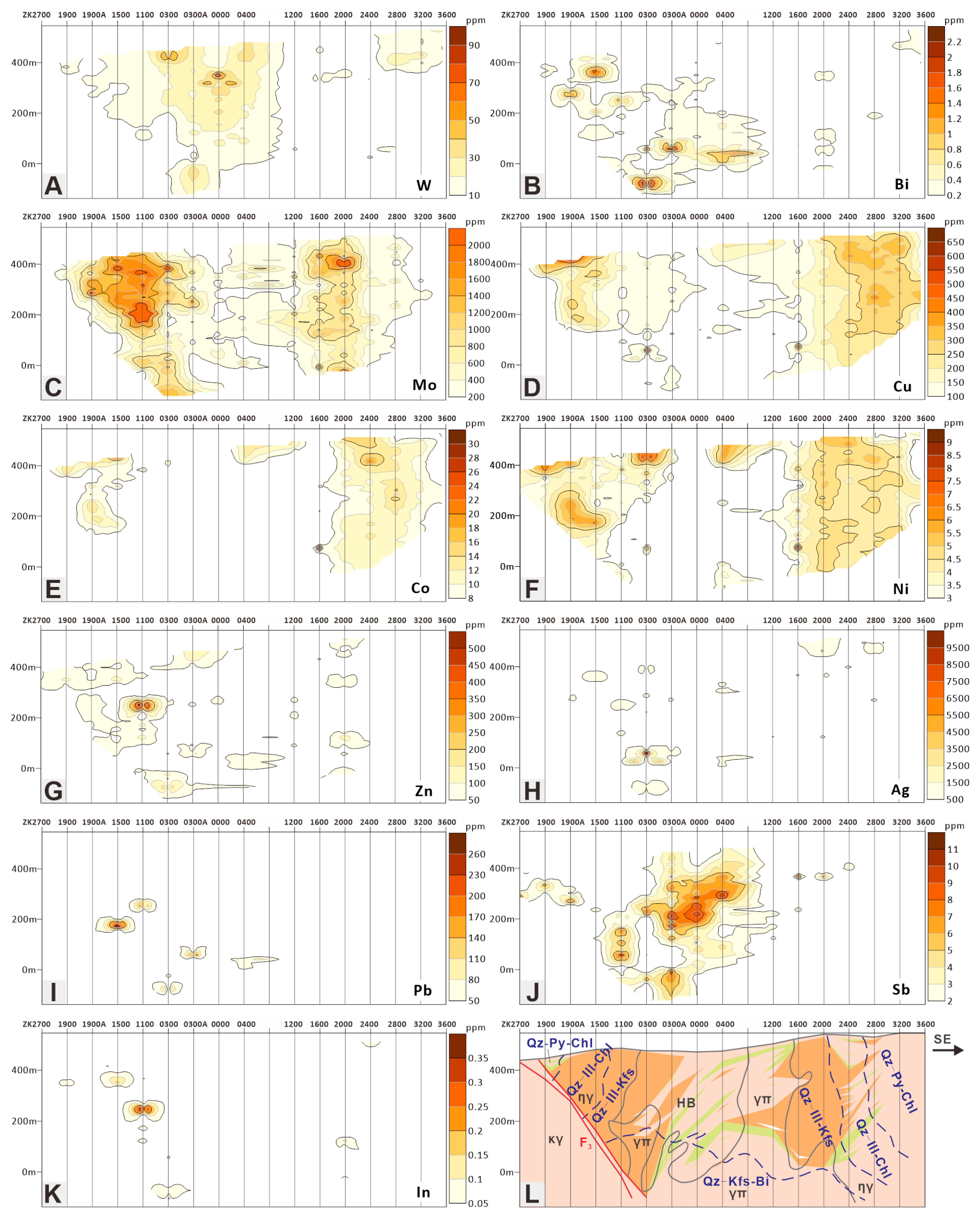
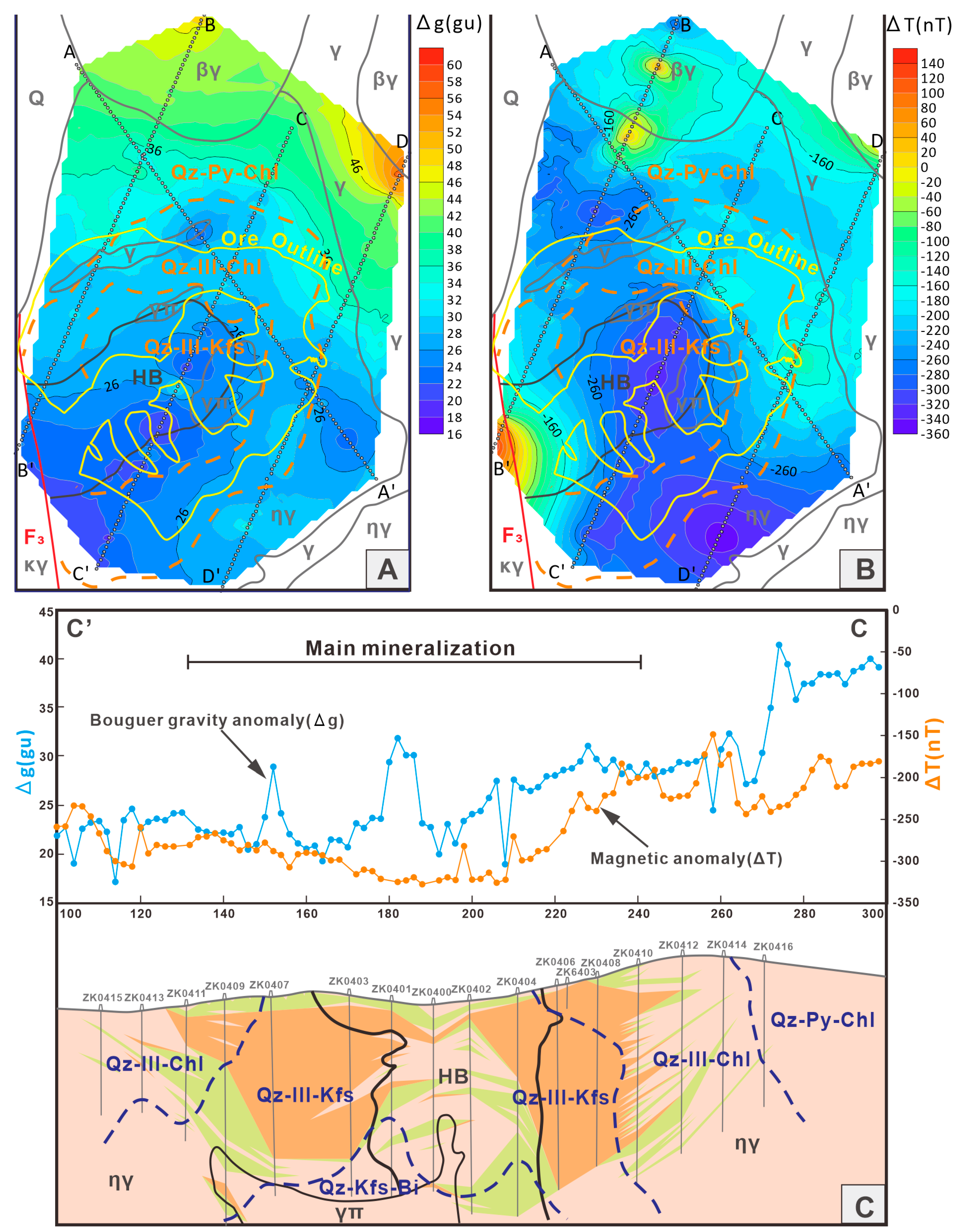

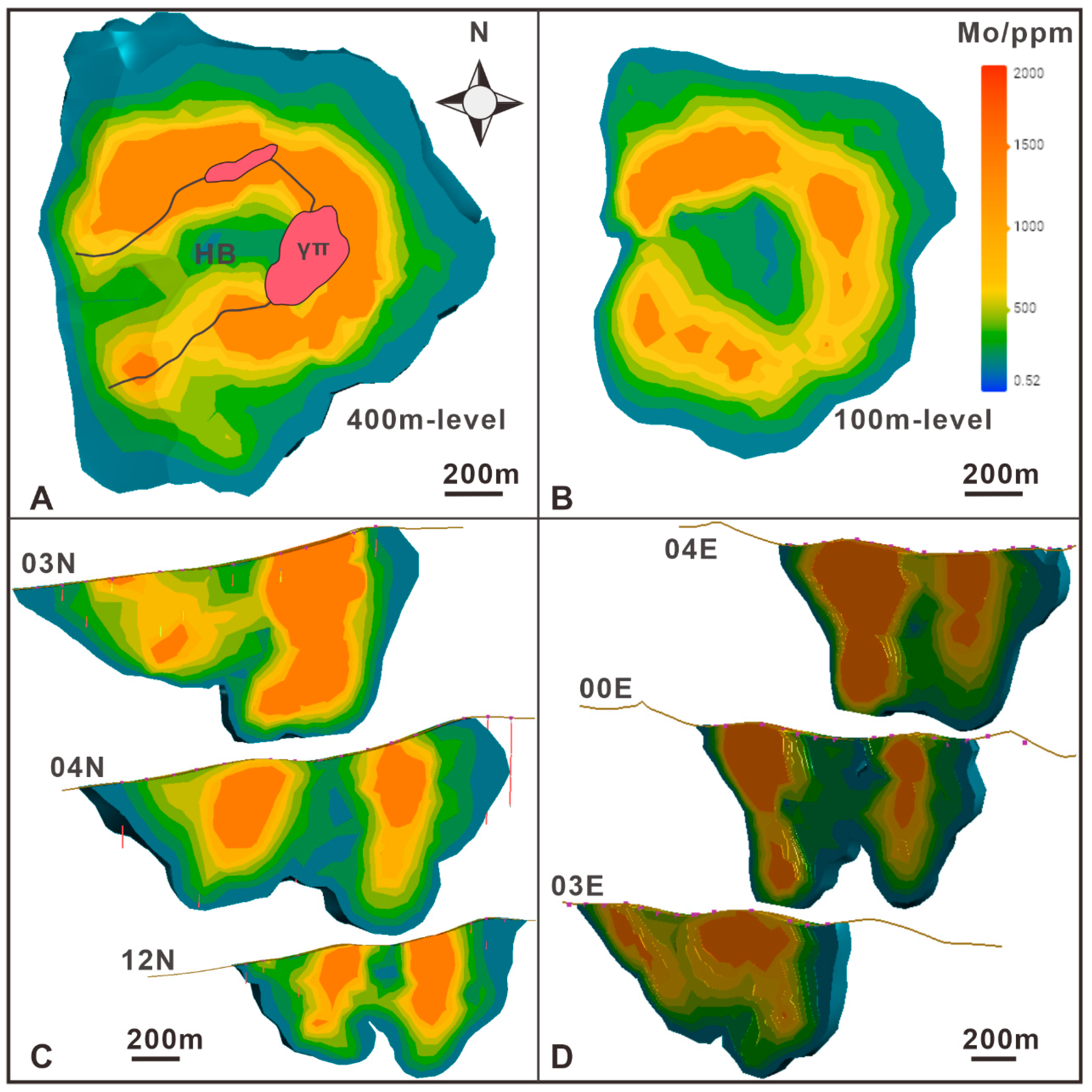
| Valid N | Mean ppm | Median ppm | Minimum ppm | Maximum ppm | Std.Dev. ppm | Coef.Var. % | Skewness | Kurtosis | |
|---|---|---|---|---|---|---|---|---|---|
| Mo | 27,942 | 516.40 | 281.41 | 0.52 | 24,790.0 | 758.7 | 147 | 7 | 100 |
| Ag | 26,900 | 307.87 | 190.99 | 0.31 | 82,561.2 | 1149.8 | 373 | 42 | 2377 |
| Bi | 26,900 | 0.30 | 0.14 | 0.01 | 162.3 | 1.9 | 638 | 48 | 3187 |
| Co | 26,900 | 7.79 | 7.86 | 0.07 | 272.7 | 4.3 | 55 | 10 | 548 |
| Cu | 26,900 | 171.46 | 159.84 | 1.00 | 5721.7 | 121.3 | 71 | 9 | 308 |
| In | 26,900 | 0.04 | 0.02 | 0.00 | 21.9 | 0.2 | 612 | 72 | 6478 |
| Ni | 26,900 | 3.71 | 3.78 | 0.07 | 978.0 | 7.7 | 206 | 107 | 12,552 |
| Pb | 26,900 | 24.40 | 12.71 | 0.43 | 18,811.0 | 194.0 | 795 | 62 | 5010 |
| Sb | 26,900 | 1.02 | 0.28 | 0.01 | 231.8 | 2.5 | 248 | 32 | 2664 |
| W | 26,900 | 10.99 | 8.10 | 0.11 | 4757.5 | 31.2 | 284 | 132 | 19,976 |
| Zn | 26,900 | 52.27 | 29.71 | 1.99 | 31,259.7 | 306.2 | 586 | 62 | 5392 |
| Zoning | Lithology | Number of Samples | Mo ppm | Resistivity Ω·m | Chargeability % | Magnetic Susceptibility 10−6 × 4πSI | Density g/cm3 |
|---|---|---|---|---|---|---|---|
| 3 | ηr | 19 | 747 | 5340 (596–19,313) | 56.3 (18–169) | 35.2 (10–109) | 2.54 (2.43–2.63) |
| 2 | ηr + GP + HB | 58 | 690 | 4050 (242–27,683) | 50.5 (6.4–204.7) | 12.5 (0–74.0) | 2.55 (2.40–2.72) |
| 1 | HB | 10 | 1015 | 7211 (949–20,520) | 29.6 (9.9–96.2) | 7.4 (0–64.0) | 2.61 (2.48–2.78) |
| 0 * | ηr | 13 | 103 | 22,636 (3451–47,698) | 12.8 (9.7–18.0) | 234.7 (87.0–408.0) | 2.58 (2.38–2.72) |
Disclaimer/Publisher’s Note: The statements, opinions and data contained in all publications are solely those of the individual author(s) and contributor(s) and not of MDPI and/or the editor(s). MDPI and/or the editor(s) disclaim responsibility for any injury to people or property resulting from any ideas, methods, instructions or products referred to in the content. |
© 2024 by the authors. Licensee MDPI, Basel, Switzerland. This article is an open access article distributed under the terms and conditions of the Creative Commons Attribution (CC BY) license (https://creativecommons.org/licenses/by/4.0/).
Share and Cite
Gao, B.; Dong, M.; Xie, H.; Liu, Z.; Li, Y.; Zhou, T. Discovery and Exploration of the Luming Porphyry Mo Deposit, Northeastern China: Implications for Regional Prospecting. Minerals 2024, 14, 718. https://doi.org/10.3390/min14070718
Gao B, Dong M, Xie H, Liu Z, Li Y, Zhou T. Discovery and Exploration of the Luming Porphyry Mo Deposit, Northeastern China: Implications for Regional Prospecting. Minerals. 2024; 14(7):718. https://doi.org/10.3390/min14070718
Chicago/Turabian StyleGao, Bangfei, Minghua Dong, Hui Xie, Zhiliang Liu, Yihang Li, and Tong Zhou. 2024. "Discovery and Exploration of the Luming Porphyry Mo Deposit, Northeastern China: Implications for Regional Prospecting" Minerals 14, no. 7: 718. https://doi.org/10.3390/min14070718






